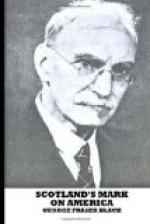love and tindir affectioun” for his Scottish
subjects had decided that they were to be allowed
a share, and he adds, that here is a great opportunity
for Scotland since “we haif greitt advantaige
of transporting of our men and bestiall [i.e., live
stock of a farm] in regairde we lye so neir to that
coiste of Ulster.” Immediately on receipt
of this letter the Scottish Privy Council made public
proclamation of the news and announced that those of
them “quho ar disposit to tak ony land in Yreland”
were to present their desires and petitions to the
Council. The first application enrolled was by
“James Andirsoun portionair of Litle Govane,”
and by the 14th of September seventy-seven Scots had
come forward as purchasers. If their offers had
been accepted, they would have possessed among them
141,000 acres of land. In 1611, in consequence
of a rearrangement of applicants the number of favored
Scots was reduced to fifty-nine, with eighty-one thousand
acres of land at their disposal. Each of these
“Undertakers,” as they were called, was
accompanied to his new home by kinsmen, friends, and
tenants, as Lord Ochiltree, for instance, who is mentioned
as having arrived “accompanied with thirty-three
followers, a minister, some tenants, freeholders,
[and] artificers.” By the end of 1612 the
emigration from Scotland is estimated to have reached
10,000. Indeed, before the end of this year so
rapidly had the traffic increased between Scotland
and Ireland that the passage between the southwest
of Scotland and Ulster “is now become a commoun
and are ordinarie ferrie,” the boat-men of which
were having a rare time of it by charging what they
pleased for the passage or freight. In the selection
of the settlers measures were carefully taken that
they should be “from the inwards part of Scotland,”
and that they should be so located in Ulster that
“they may not mix nor intermarry” with
“the mere Irish.” For the most part
the settlers appear to have been selected from the
shires of Dumbarton, Renfrew, Ayr, Galloway, and Dumfries.
Emigration from Scotland to Ireland appears to have
continued steadily and the English historian Carte
estimated, after diligent documentary study, that
by 1641 there were in Ulster 100,000 Scots and 20,000
English settlers. In 1656 it was proposed by the
Irish government that persons “of the Scottish
nation desiring to come into Ireland” should
be prohibited from settling in Ulster or County Louth,
but the scheme was not put into effect. Governmental
opposition notwithstanding emigration from Scotland
to Ireland appears to have continued steadily, and
after the Revolution of 1688 there seems to have been
a further increase. Archbishop Synge estimated
that by 1715 not less than 50,000 Scottish families
had settled in Ulster during these twenty-seven years.
It should be also mentioned that “before the
Ulster plantation began there was already a considerable
Scottish occupation of the region nearest to Scotland.
These Scottish settlements were confined to counties
Down and Antrim, which were not included in the scheme
of the plantation. Their existence facilitated
Scottish emigration to the plantation and they were
influential in giving the plantation the Scottish
character which it promptly acquired. Although
planned to be in the main an English settlement, with
one whole county turned over to the city of London
alone, it soon became in the main a Scottish settlement.”




